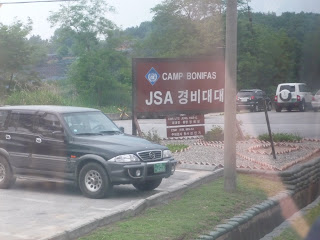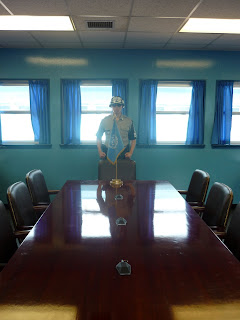Our first glimpse of North Korea and we hadn't even reached the DMZ yet. This was taken from the bus on the way there, not very far out of Seoul.



Camp Bonifas, named after Captain Arthur Bonifas who was killed in the Axe Murder Incident. It is the site of the world's most dangerous golf course: a one-hole course surrounded by mine fields on three sides.


We had to watch a presentation and sign a waiver before entering the Joint Security Area.


Notice the words about death.

We didn't mind though. We happily signed the 'it's not the USO's fault if we die' forms. The presentation gave a brief history of the Korean war and how the DMZ was established and what had happened since then. It was given by a US soldier and was, at times, pretty biased, but still very interesting.

Seeing how close it was to Seoul was a little worrying:

After the presentation, we got on new buses and were driven to the Joint Security Area.
In Panmunjeom, a village inside the Joint Security Area. American soldiers lined us up and told us to keep moving and not to point or gesture at any North Korean guards. We only saw one and I accidentally pointed at him. Oh dear.

In this picture, we're standing on the South Korean side, the blue buildings straddle the line between the two Koreas and the building behind them is North Korean.

Those South Korean army men (ROK soldiers) are practically facing into the building so that they can still see but they don't make much of a target for the North Koreans to shoot at. Might seem obvious to you but I didn't know until told.
T2 - stands for Temporary, not Terminator. This is the Military Armistice Commission conference building. The Military Demarcation Line runs right through this building, horizontally, right through the middle of the conference table.

In T2. The South Korean guards went in first and locked the door at the North Korean end. Those people round the other side of the table are standing in North Korea. We were told that sometimes the North Korean soldiers come up to the windows and peer in at the tourists but no one came up while we were there. In fact, that one soldier I pointed at (it's been about two months since we were there and nothing's happened. I'm sure I'm safe now) was the only one we saw.

Draw a line between the microphones on the table and there you have the North/South division line (Military Demarcation Line). Also, the North could hear everything we said.

The flags in the room used to be silk but one day some North Koreans took down the American flag and the South Korean flag. One soldier wiped his shoes with the American flag and the other blew his nose on the South Korean flag, so they're made of plastic and in a case now.

A South Korean soldier in the Tae Kwon Do ready position. The American soldiers must meet above aptitude requirements but these guys have to have a basic fluency in both written and spoken English, must be taller and larger than the average South Korean (ROK - Republic of Korea) solder and have a first degree black belt in a martial art. Our American soldier kept saying things like 'don't touch them or they'll stop you and you won't like that very much at all.' I believed him.
 He's also straddling the Military Demarcation Line.
He's also straddling the Military Demarcation Line.I'm in North Korea and South Korea at the same time. I'm in two countries at once!

Look! One foot in each! I'm in Koreas!

Simon and I are on the North Korean side here. To the left of the soldier is South Korea. Notice how I don't want to get too close to him, just in case.

We're in North Korea! It's scary here.

It sounds silly to say it but although it really was just a case of walking round a table and being told you were in North Korea, my heart started beating just a little quicker. It was quite exciting.
This ROK soldier was standing in front of the door that led to North Korea. They were like statues but you can bet that they really were ready for anything.


The second group going into T2, about to set foot in North Korea:

There it is. That raised concrete line is the Military Demarcation Line (MDL). Step over it and you've defected to North Korea.

We were being watched the whole time we were there. That's a North Korean guard tower.

There's the one DPRK (Democratic Peoples' Republic of Korea - the official name of North Korea) soldier we saw. He looked at us with some binoculars.

See him?
 (Click on the picture to make it bigger and you can see him clearly)
(Click on the picture to make it bigger and you can see him clearly)This is the former site of the sunken gardens, which saw a gunfight in November 1984 after a Russian translator, who was part of a sightseeing trip through a North Korean agency, defected by crossing the MDL into South Korea. He was followed by some DPRK soldiers, who shot and killed a ROK solder and injured a US soldier trying to get him back (or kill him). In total, 17 DPRK soldiers crossed the MDL (although since reading more about it, I've also read that it was 30 so I'm not too sure. The book I bought at the DMZ says 17), 3 of whom were shot and killed by UNC soldiers. 5 others were wounded. They said that the Russian became a journalist but I haven't found any more information on him.



We then got back on the buses and went to checkpoint 5, where you can see the North Korean 'Propaganda Village'. Views of the DMZ, looking towards North Korea:


There it is. Kijong-dong, otherwise known as Propaganda Village. It's apparently an empty village that buses in 'villagers' every morning to do healthy family activities etc under ROK scrutiny, so that everyone can see how good life is in the DPRK (concentration camps? Not in our country!) and it pumps out propaganda for hours every day that the ROK and US soldiers can hear too, apparently to encourage ROK soldiers and Taeseong-dong villagers to defect. Apparently, the buildings have no rooms inside and not even any floors. They're just shells. The flagpole is 160 metres tall, the tallest in the world, a result of a 'flagpole war' with the South Korean village of Taeseong-dong (the only South Korean village in the DMZ), whose flagpole is 100 metres tall. The giant North Korean flag weighs 270kg!

That's North Korea behind me!


Looking down on the Bridge of No Return.
 The world's tallest flagpole:
The world's tallest flagpole:
Bridge of No Return again and checkpoint 3:

Seriously. North Korea. Right there.

The DMZ's sort of a wildlife haven, which the guides made quite a lot of. We saw these as we were driving down to the Bridge of No Return.

This marks the spot of the poplar tree that sparked the Axe Murder incident of 1976. It blocked the view between checkpoints 3 and 4, so a small group of American and ROK soldiers went to trim it. Some DPRK soldiers challenged them and it ended in two American soldiers being axed to death. North Korea has the axe on display on their side, apparently.
 The book I bought actually has photos of this, with arrows to 'highlight North Korean atrocities'. It's a pretty gruesome story. You can read more here (or search for a more trusted site) to get an idea of what went on.
The book I bought actually has photos of this, with arrows to 'highlight North Korean atrocities'. It's a pretty gruesome story. You can read more here (or search for a more trusted site) to get an idea of what went on.The picture below shows us approaching checkpoint 3, which stands on the South Korean side of the Bridge of No Return. If you have seen 'JSA', the Korean film, this may look familiar to you. Watch it, it's fantastic. I think someone said they also used the Bridge of No Return in a Bond film.
 It's not used any more and it got its name because it was where prisoners of war were exchanged after the Korean War. They could choose which side to stay on but once their choice was made, there was no going back.
It's not used any more and it got its name because it was where prisoners of war were exchanged after the Korean War. They could choose which side to stay on but once their choice was made, there was no going back.
After this, we went to the DMZ giftshop!
 Then we went to an obseration area, where you're allowed to put money into the binoculars and gawp at Propaganda Village etc. (and boy did I gawp) but you have to stand behind a line to take photos.
Then we went to an obseration area, where you're allowed to put money into the binoculars and gawp at Propaganda Village etc. (and boy did I gawp) but you have to stand behind a line to take photos.



There I am having a good old gander at the other Korea. I don't need no box to stand on.


After the observation (which included a presentation), we were driven to the Third Tunnel of Aggression, which I think is the tunnel with the best name ever. It's actually quite scary but more on that later....
We went to a museum first, which had all sorts of information about the war, the DMZ, the tunnels etc. Here is Panmunjeom:
 The Bridge of No Return:
The Bridge of No Return: The DMZ. Here you can see the DMZ and the MDL going through the middle of it.
The DMZ. Here you can see the DMZ and the MDL going through the middle of it.
Unfortunately, I have no photos of the tunnel, as you weren't allowed to take pictures. To explain:
Since the 1970s, South Korea has found four tunnels that come under the DMZ from North Korea. The first was discovered in 1974, 65km from Seoul and the most recent one was found in 1990. We went into the third tunnel, discovered in 1978, which is only 44km away from Seoul. North Korea claims the tunnels were dug for coal mining and they had painted the granite walls black inside, to support this claim.
The third tunnel was small, smelly, damp and very, very long. You only go as far as the first blockade but it's a long way. You wear a hardhat, which you keep bashing against the ceiling or the scaffolding supporting the ceiling, and you wander along at a crouch, out of breath, for a really long time. You reach the end, turn around and go back. It was pretty amazing, being in a tunnel that had been dug by the North to invade the South (our tourlady Jean called it the 'North Korean-dug fitness facility'), especially seeing the black-painted walls and thinking of the years it had taken to dig. But it is just a really long tunnel and there really is no need to walk all the way to the first blockade. I'm glad I went but I probably won't go again. We are planning to visit the DMZ at least once more.
We were told that they suspect there are at least 10 more tunnels, still undiscovered.
It was an amazing and fascinating day trip and, by far, the best thing we've done in Korea. It's made me even more obsessed with the North (not in a defecty way). It's hard to believe it's all so close to us. Sadly though, it made reunification seem that little bit further away.

